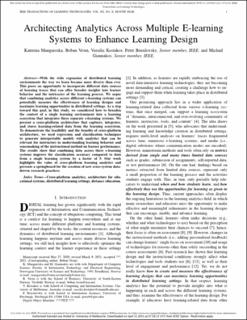| dc.contributor.author | Mangaroska, Katerina | |
| dc.contributor.author | Vesin, Boban | |
| dc.contributor.author | Kostakos, Vassilis | |
| dc.contributor.author | Brusilovsky, Peter | |
| dc.contributor.author | Giannakos, Michail | |
| dc.date.accessioned | 2022-04-06T11:31:37Z | |
| dc.date.available | 2022-04-06T11:31:37Z | |
| dc.date.created | 2021-04-28T09:21:06Z | |
| dc.date.issued | 2021 | |
| dc.identifier.citation | IEEE Transactions on Learning Technologies. 2021, 14 (2), 173-188. | en_US |
| dc.identifier.issn | 1939-1382 | |
| dc.identifier.uri | https://hdl.handle.net/11250/2990200 | |
| dc.description.abstract | With the wide expansion of distributed learning environments the way we learn became more diverse than ever. This poses an opportunity to incorporate different data sources of learning traces that can offer broader insights into learner behavior and the intricacies of the learning process. We argue that combining analytics across different e-learning systems can potentially measure the effectiveness of learning designs and maximize learning opportunities in distributed settings. As a step toward this goal, in this study, we considered how to broaden the context of a single learning environment into a learning ecosystem that integrates three separate e-learning systems. We present a cross-platform architecture that captures, integrates, and stores learning-related data from the learning ecosystem. To demonstrate the feasibility and the benefits of cross-platform architecture, we used regression and classification techniques to generate interpretable models with analytics that can be relevant for instructors in understanding learning behavior and sensemaking of the instructional method on learner performance. The results show that combining data across three e-learning systems improve the classification accuracy compared to data from a single learning system by a factor of 5. This article highlights the value of cross-platform learning analytics and presents a springboard for the creation of new cross-system data-driven research practices. | en_US |
| dc.language.iso | eng | en_US |
| dc.publisher | IEEE | en_US |
| dc.relation.uri | https://drive.google.com/file/d/1h6DDX15uckbw4dpeMTzRjj8kRi2e9zWg/view | |
| dc.title | Architecting Analytics Across Multiple E-learning Systems to Enhance Learning Design | en_US |
| dc.type | Journal article | en_US |
| dc.type | Peer reviewed | en_US |
| dc.description.version | acceptedVersion | en_US |
| dc.rights.holder | © 2021 IEEE. Personal use of this material is permitted. Permission from IEEE must be obtained for all other uses, in any current or future media, including reprinting/republishing this material for advertising or promotional purposes, creating new collective works, for resale or redistribution to servers or lists, or reuse of any copyrighted component of this work in other works | en_US |
| dc.source.pagenumber | 173-188 | en_US |
| dc.source.volume | 14 | en_US |
| dc.source.journal | IEEE Transactions on Learning Technologies | en_US |
| dc.source.issue | 2 | en_US |
| dc.identifier.doi | 10.1109/TLT.2021.3072159 | |
| dc.identifier.cristin | 1906850 | |
| cristin.ispublished | true | |
| cristin.fulltext | postprint | |
| cristin.qualitycode | 1 | |
